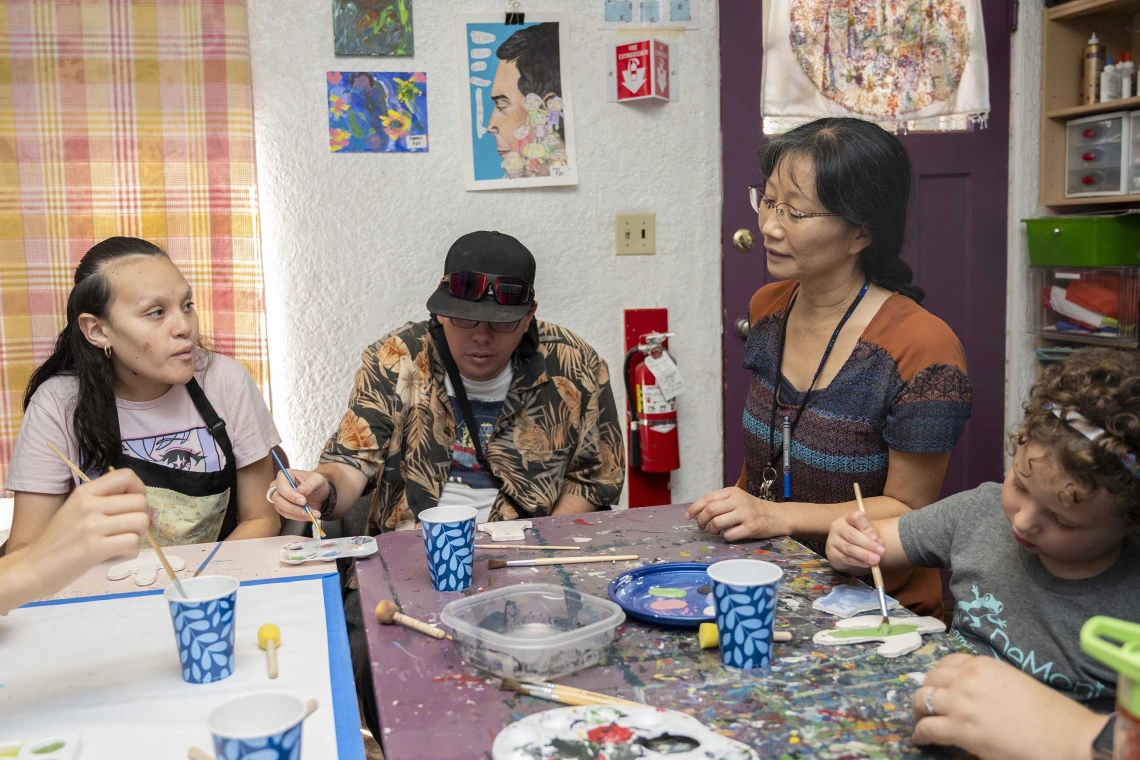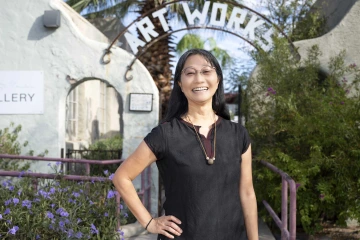Yumi Shirai brings together art and health sciences
ArtWorks director bridges worlds for adults with developmental disabilities and medical students through collaborative projects.

As a University of Arizona graduate student in 1998, Yumi Shirai, PhD, was a student worker at ArtWorks. Now she’s director of the all-day art program for adults with developmental disabilities.
Photo By Noelle Haro-Gomez, U of A Health Sciences Office of Communications
It’s barely 8:30 on a Friday morning, but ArtWorks, an all-day art program for adults with developmental disabilities, is buzzing with activity.
One woman is seated at a desk, ready to create. Another woman surveys the stacks of handmade calendars and small ceramic ornaments waiting to be sold at a weekend pop-up shop. Half a dozen artists sit in a circle, chatting, before they start work on their projects.

A trained dancer, Yumi Shirai, PhD, took art therapy classes and pivoted to movement therapy to help aging adults and those with developmental disabilities.
Photo By Noelle Haro-Gomez, U of A Health Sciences Office of Communications
This is the quiet part of the day when Yumi Shirai, PhD, can catch up before diving into her role as director of the outreach program with the University of Arizona College of Medicine – Tucson’s Department of Family & Community Medicine and the Sonoran Center for Excellence in Disabilities.
Shirai doesn’t mind pausing when a young man pops in to show off his right pinkie, which he injured playing softball. He apologizes for interrupting, but he’s excited to share that he no longer needs to wear a splint.
“Watch out,” Shirai tells him. “You don’t want to bump it. Be careful.”
Housed in three old Tucson bungalows on Helen Street in the shadows of the Highland Parking Garage and the Andrew Weil Center for Integrative Medicine, ArtWorks feels cozy, comforting and familial.
Because it is.
“Our ArtWorks folks say this is their second family,” Shirai said. “Many have been in the program for a long time. They have confidence that this is their space.
“They are part of the university, and they are also part of the educational team. Although they may not know the words ‘educational team,’ they know what impact they bring to the education of future professionals and community members.”
Connecting through art
Art is powerful. It transforms, changes and expands the way we see the world. That’s the goal of ArtWorks, which promotes community and connection through creative projects between adults with intellectual and developmental disabilities and U of A students.
Shirai experienced this firsthand when she was a student worker at ArtWorks in 1998. She had moved from Japan to pursue a master’s in dance/movement therapy at the university. It didn’t matter that Shirai wasn’t fluent in English or that the adults she was working with had their own challenges communicating.
“They didn’t look down upon me, and I didn’t look down upon them,” she said. “Initially, my impression was that we are different, but as we get to know each other, we discovered we have some things in common and to share. And that’s the beauty of ArtWorks.”
The program began in 1994 as a collaborative effort between Sister Jeanne Carrigan, PhD, an educator and therapist, and Mary Paulin, an art teacher and U of A art museum volunteer.
You may have seen ArtWorks pop-up sales or exhibitions around the Tucson campus. A new mural by ArtWorks artists and medical students was unveiled in August at the College of Medicine – Tucson’s social hall. Another ongoing project is the tile mosaic outside the entrance to the College of Medicine – Tucson.
This past summer, ArtWorks received an award from the Aging and Disability Business Institute at USAging for its unique scrapbook-making workshop that helped artists and their caregivers create an alternative Person-Centered Plan, which is required health care information for those with intellectual disabilities who receive Medicare and Medicaid-funded services. Documentation in a traditional, typewritten form is difficult for those who struggle to read and write, but ArtWorks’ approach to using visuals and letting artists decorate in their own way made the task engaging and the information meaningful.
“Their dedication to innovative solutions in health care has not only set a benchmark for excellence but also aligns perfectly with our mission to drive impactful change,” USAging CEO Sandy Markwood said about the program. “These pioneers have demonstrated extraordinary creativity and commitment to improving the lives of older adults and people with disabilities, and their achievements inspire us all to continue pushing the boundaries of what’s possible. We are honored to support and celebrate such remarkable contributions to the field.”
From dancer to director
Shirai said she never imagined she’d head up ArtWorks one day. In fact, she never even saw herself teaching. She loved to move, following her older sister into modern dance when Shirai was just 3 years old.

For both the artists and U of A medical students who work with them, ArtWorks is like a second family, Yumi Shirai says.
Photo By Noelle Haro-Gomez, U of A Health Sciences Office of Communications
It remained her passion as a student at Nihon University in Tokyo. However, Shirai’s parents, both educators, urged her to have a backup plan. That turned out to be solid advice.
When Shirai realized she didn’t want to dance professionally, she explored movement therapy. Options were limited in Japan, so Shirai shifted her sights to the United States. She joked that her search stopped at universities starting with “A” because her English was limited.
At the U of A, she took two art therapy classes with Carrigan and loved the idea of using her dance training to improve the lives of aging adults and those with developmental disabilities.
Shirai, an associate professor in Family & Community Medicine, in Applied Intercultural Arts Research and in Innovation in Aging, teaches the FCM 424 and 524a-c interdisciplinary classes. She is also the co-chair of the scholarly projects program and mentors students in the Commitment to Underserved People program, which partners with ArtWorks.
The artists enrolled in the program range widely in age. Some have limited mobility, while others have limited communication skills. But there are no limitations when it comes to expressing their ideas and sharing the joy of creativity and life through art.
It is an invaluable experience for medical students to interact outside a clinical setting with those who have intellectual disabilities, Shirai said. In a clinician-patient setting, students may feel like they’re fixing someone’s issue, she said. With art, however, it’s a truly collaborative effort, with both working together as equals. It’s common for students to graduate, become physicians and come back to visit ArtWorks and take the artists out to lunch as friends.
“Once you become part of the ArtWorks family, you don’t forget it,” Shirai said. “They have that connection. The group creative process not only brings joy but also generates solutions for the communities and individuals involved. They see parallels between the collaborative approach and team science experienced at ArtWorks and their professional life in medical practice. So, they keep coming back, and I think that’s a very beautiful part of ArtWorks.”

